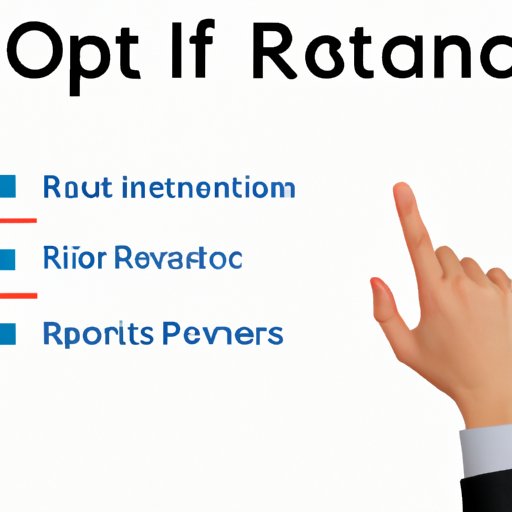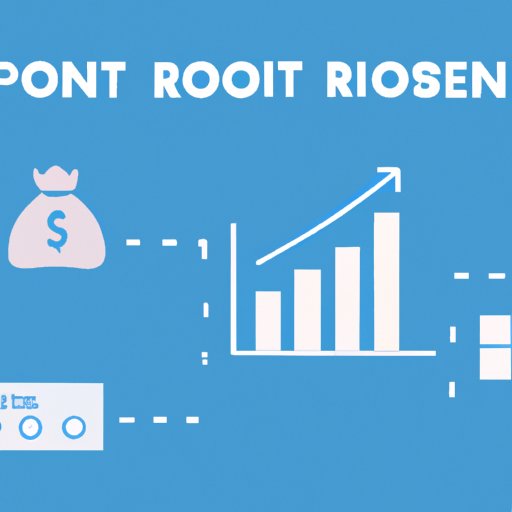Introduction
Return on investment (ROI) is a financial metric used to measure the efficiency of an investment or compare the profitability of multiple investments. It is used to evaluate the performance of an investment over time, as well as to compare different investments against each other. Understanding and correctly calculating ROI is essential for any business decision-making process.

Explaining the Basics of ROI
To understand how to calculate ROI, it is important to first understand what ROI is. ROI is essentially an equation that measures how much money an investor can expect to make from an investment, relative to the amount of money they put in. It is calculated by subtracting the initial cost of the investment from its current value, and then dividing that figure by the initial cost of the investment. The result is expressed as a percentage.
The components of ROI include the initial investment, the return on the investment, and the time frame that the investment is held. Different types of ROI can be calculated depending on the type of investment and the time frame it is held. For example, short-term investments might be evaluated with a shorter time frame, while long-term investments might be evaluated with a longer time frame.

Outlining Simple Methods for Calculating ROI
Calculating ROI can be done using formulas or by analyzing the costs and benefits of an investment. When using formulas, investors typically use the following formula: ROI = (Gain – Cost) / Cost. This formula allows investors to quickly calculate the ROI of an investment by subtracting the cost of the investment from the gain it produces, and then dividing that figure by the cost of the investment.
Alternatively, investors can also analyze the costs and benefits of an investment to get a more accurate picture of its ROI. This involves looking at the total costs associated with the investment, such as any fees or taxes, and then comparing them to the expected benefits, such as potential profits or increased market share. By doing this, investors can get a more precise idea of the ROI of an investment.
Demonstrating How to Use ROI in Business Decision Making
Once investors have calculated the ROI of an investment, they can use the information to evaluate different investment opportunities and assess the overall performance of their portfolio. Using ROI to evaluate investments can help investors decide which investments are likely to generate the most profit, as well as identify any potential risks associated with the investment.
For example, if an investor is considering two different investments, they can use the ROI of each investment to determine which one is likely to generate the most profit. Similarly, if an investor is trying to assess the overall performance of their portfolio, they can use the ROI of each investment to gauge which investments are performing better than others.

Showcasing Examples of Companies that Have Used ROI to Improve Profits
Using ROI to evaluate investments has been proven to be an effective way to improve profits. Many successful companies have used ROI to identify profitable investments and maximize returns. For example, Amazon has used ROI to invest in new technologies and services, which have helped the company increase its profits in both the short and long term.
Similarly, Walmart has used ROI to identify and invest in new products and services that have generated significant returns for the company. By using ROI to evaluate potential investments, Walmart has been able to identify profitable opportunities that have allowed the company to increase its profits and stay competitive in the market.
Detailing Different Types of ROI and Their Advantages
There are several different types of ROI that investors can use to evaluate investments. These include financial ROI, economic value added (EVA), and social return on investment (SROI). Each type of ROI has its own advantages and disadvantages, and investors should take these into consideration when evaluating potential investments.
Financial ROI is the most commonly used type of ROI and is used to measure the financial performance of an investment. EVA is similar to financial ROI but takes into account factors such as taxes and inflation. SROI is a newer type of ROI that takes into account both financial and non-financial factors, such as environmental and social impacts. Each type of ROI has its own advantages and disadvantages, and investors should choose the one that best fits their needs.
Examining the Role of Risk in Calculating ROI
When calculating ROI, investors should also take into account the potential risks associated with the investment. Risks can include anything from market volatility to political instability. Investors should identify potential risks before investing, and then plan accordingly to mitigate those risks.
For example, if an investor is considering investing in a foreign currency, they should research the political and economic stability of the country before investing. By doing so, they can reduce the risk of losing money due to currency fluctuations or political unrest.
Discussing the Benefits of Long-Term ROI Planning
In addition to evaluating individual investments, investors should also consider the long-term implications of their investments. Long-term ROI planning involves setting goals and objectives, as well as identifying strategies for achieving sustainable growth. By taking a long-term approach to ROI planning, investors can ensure that their investments are working towards their ultimate goals.
For example, if an investor is looking to retire early, they should set long-term goals and develop a plan for achieving those goals. This could involve investing in stocks and bonds, as well as diversifying their portfolio to minimize risk. By taking a long-term approach to ROI planning, investors can ensure that their investments will generate the highest possible returns over time.
Conclusion
Return on investment (ROI) is an important metric for evaluating investments and assessing overall performance. Understanding and correctly calculating ROI is essential for any business decision-making process. This article has provided an in-depth guide to understanding and calculating ROI, including explanations of the basics of ROI, simple methods for calculating it, how to use it in business decision making, examples of companies that have used it to improve profits, different types of ROI and their advantages, the role of risk in calculating ROI, and the benefits of long-term ROI planning.
(Note: Is this article not meeting your expectations? Do you have knowledge or insights to share? Unlock new opportunities and expand your reach by joining our authors team. Click Registration to join us and share your expertise with our readers.)
